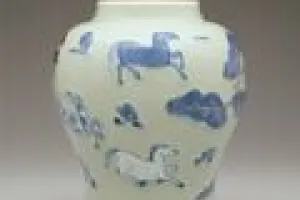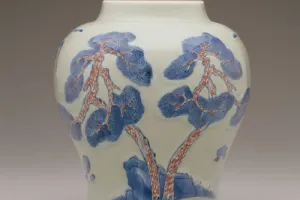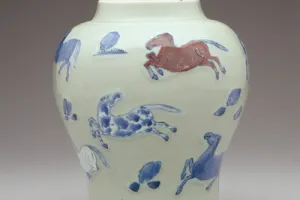OVIFORM JAR WITH THE EIGHT HORSES OF KING MU WANG
Creator(s): Unknown (Ceramicist)
On view in: Dining Room
About this object
This oviform jar is decorated with the Eight Horses of King Mu Wang among rockwork with scenes divided vertically by a tall pine tree rising to the rim. The exterior was carved in low relief to depict the horses in the landscape and then decorated with underglaze blue and copper red set against a celadon ground. The eight mythical steeds of Mu Wang (trad. 1001-947 B.C.E.), the fifth sovereign of the Chou dynasty, were used to drive the King through the Empire and to visit the Queen Mother of the West. Celadon is a high-fired green glaze that receives it color from small traces of iron and titanium oxides when fired in a reducing atmosphere. The term originated from Celadon, the shepherd in the stage version of Honore d'Urfe's pastoral romance L'Astree, who wore ribbons of a soft gray-green tone. The mark is an underglaze blue artemesia leaf under the foot. The vase has a later carved teak covere with turquoise finial carved in the shape of a peach and rests on a later carved teak stand.
This oviform jar is decorated with the Eight Horses of King Mu Wang among rockwork with scenes divided vertically by two tall pine tree rising to the shoulders. The exterior was carved in low relief to depict the horses in the landscape and then decorated with underglaze blue and copper red set against a celadon ground. The jar has a later wood cover featuring an openwork design and finial of carved turquoise in the form of a peach.
- Object name:
- OVIFORM JAR WITH THE EIGHT HORSES OF KING MU WANG
- Made from:
- Carved porcelain with underglaze blue and copper red on celadon ground -- wood -- turquoise
- Made in:
- Jingdezhen, China
- Date made:
- 1700-1722
- Size:
- H. 10 1/2 × Diam. 8 1/2 in. (26.7 × 21.6 cm) with lid, on wood stand: H. 16 in. (40.6 cm)
Detailed information for this item
- Catalog number:
- 26.253.3-4
- Class:
- CERAMICS
- Signature marks:
- Credit line:
- Bequest of Marjorie Merriweather Post, 1973



